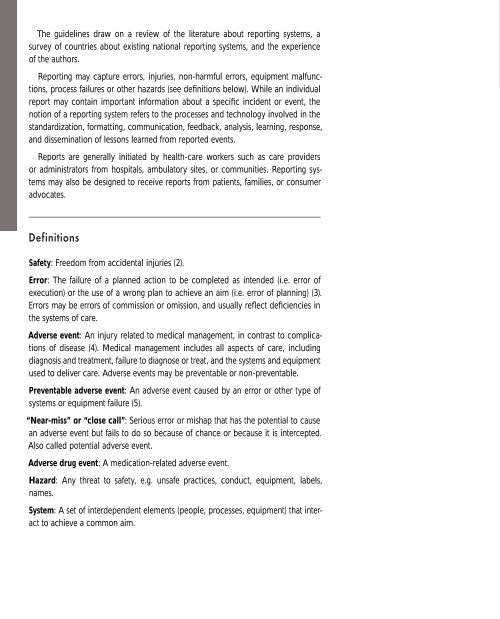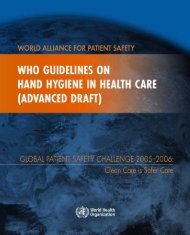Adverse event reporting.pdf
Adverse event reporting.pdf
Adverse event reporting.pdf
You also want an ePaper? Increase the reach of your titles
YUMPU automatically turns print PDFs into web optimized ePapers that Google loves.
The guidelines draw on a review of the literature about <strong>reporting</strong> systems, a<br />
survey of countries about existing national <strong>reporting</strong> systems, and the experience<br />
of the authors.<br />
Reporting may capture errors, injuries, non-harmful errors, equipment malfunctions,<br />
process failures or other hazards (see definitions below). While an individual<br />
report may contain important information about a specific incident or <strong>event</strong>, the<br />
notion of a <strong>reporting</strong> system refers to the processes and technology involved in the<br />
standardization, formatting, communication, feedback, analysis, learning, response,<br />
and dissemination of lessons learned from reported <strong>event</strong>s.<br />
Reports are generally initiated by health-care workers such as care providers<br />
or administrators from hospitals, ambulatory sites, or communities. Reporting systems<br />
may also be designed to receive reports from patients, families, or consumer<br />
advocates.<br />
Definitions<br />
Safety: Freedom from accidental injuries (2).<br />
Error: The failure of a planned action to be completed as intended (i.e. error of<br />
execution) or the use of a wrong plan to achieve an aim (i.e. error of planning) (3).<br />
Errors may be errors of commission or omission, and usually reflect deficiencies in<br />
the systems of care.<br />
<strong>Adverse</strong> <strong>event</strong>: An injury related to medical management, in contrast to complications<br />
of disease (4). Medical management includes all aspects of care, including<br />
diagnosis and treatment, failure to diagnose or treat, and the systems and equipment<br />
used to deliver care. <strong>Adverse</strong> <strong>event</strong>s may be pr<strong>event</strong>able or non-pr<strong>event</strong>able.<br />
Pr<strong>event</strong>able adverse <strong>event</strong>: An adverse <strong>event</strong> caused by an error or other type of<br />
systems or equipment failure (5).<br />
“Near-miss” or “close call”: Serious error or mishap that has the potential to cause<br />
an adverse <strong>event</strong> but fails to do so because of chance or because it is intercepted.<br />
Also called potential adverse <strong>event</strong>.<br />
<strong>Adverse</strong> drug <strong>event</strong>: A medication-related adverse <strong>event</strong>.<br />
Hazard: Any threat to safety, e.g. unsafe practices, conduct, equipment, labels,<br />
names.<br />
System: A set of interdependent elements (people, processes, equipment) that interact<br />
to achieve a common aim.
















